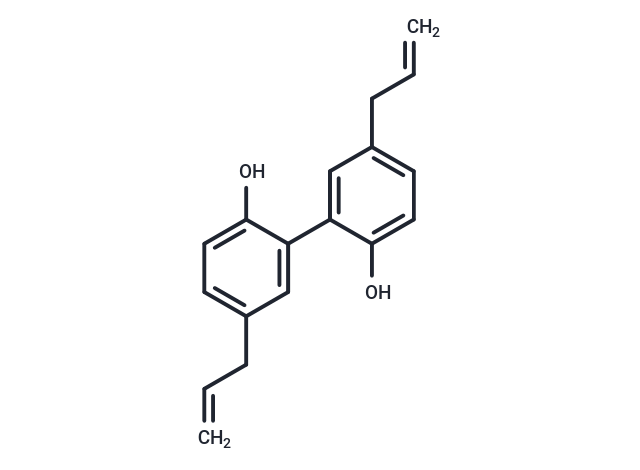Shopping Cart
- Remove All
 Your shopping cart is currently empty
Your shopping cart is currently empty

Magnolol (5,5'-Diallyl-2,2'-biphenyldiol) is a dual agonist of RXRα( EC50=10.4 μM) and PPARγ(EC50=17.7 μM). It blocks TNF-α-induced NF-KB activation.

| Pack Size | Price | Availability | Quantity |
|---|---|---|---|
| 10 mg | $39 | In Stock | |
| 25 mg | $66 | In Stock | |
| 50 mg | $97 | In Stock | |
| 100 mg | $155 | In Stock | |
| 500 mg | $389 | In Stock | |
| 1 g | $572 | In Stock | |
| 1 mL x 10 mM (in DMSO) | $30 | In Stock |
| Description | Magnolol (5,5'-Diallyl-2,2'-biphenyldiol) is a dual agonist of RXRα( EC50=10.4 μM) and PPARγ(EC50=17.7 μM). It blocks TNF-α-induced NF-KB activation. |
| Targets&IC50 | RXRα:10.4 μM (EC50), PPARγ:17.7 μM (EC50) |
| In vitro | Magnolol shows significant inhibitory activities against Trichophyton mentagrophytes, Microsporium gypseum, Epidermophyton floccosum, Aspergillus niger, Cryptococcus neoformans, and Candida albicans with minimum inhibitory concentrations (MIC) in a range of 25-100 μg/ml. |
| Alias | NSC 293099, 5,5'-Diallyl-2,2'-biphenyldiol |
| Molecular Weight | 266.33 |
| Formula | C18H18O2 |
| Cas No. | 528-43-8 |
| Storage | Powder: -20°C for 3 years | In solvent: -80°C for 1 year | Shipping with blue ice. | |||||||||||||||||||||||||||||||||||
| Solubility Information | DMSO: 70 mg/mL (262.83 mM) H2O: < 1 mg/mL (insoluble or slightly soluble) Ethanol: 49 mg/mL (184 mM) | |||||||||||||||||||||||||||||||||||
Solution Preparation Table | ||||||||||||||||||||||||||||||||||||
Ethanol/DMSO
| ||||||||||||||||||||||||||||||||||||

Copyright © 2015-2024 TargetMol Chemicals Inc. All Rights Reserved.